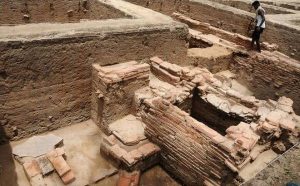As the homeless population continues to be neglected, and in some cases ignored, there remains a misunderstanding of the material possessions and the culture that accompanies being homeless. However, a recent study conducted by doctor Larry Zimmerman, a professor of anthropology at the University-Purdue University Indianapolis provides insight through an archeological perspective that strives to reverse the stigma against homelessness within the United States.
Until recently, archeology observed homelessness through a historical and ethnographic perspective, “To date, homelessness has not been the subject of systematic archeological study” (Zimmerman 2011: 68). Although this methodology enables archeologists to understand certain aspects of homelessness, it fails to address the material culture of the homeless (Figure 1). The study of such evidence would not only provide insight and explanation as to how homeless individuals live their lives, but also assist in understanding what variables affect where they live.
In 2003, Zimmerman began his archaeological study of the homeless population within the city of Indianapolis. The primary methodology of his research comprised of pedestrian surveys that identified a one-mile square radius in which the homeless population was most prevalent. Upon identifying this area of study, a series of excavations, random site surveys, and surface collections were conducted in which the volume and depth of materials found enabled Zimmerman to categorize each survey site.
Upon analyzing recorded materials from over 50 sites, each site was placed into one of three categories. Route sites, being the least occupied, offered limited evidence of sleeping or camping. Material use and disuse of this site included articles of clothing, food, and human waste. Similarly, short-term sites produced articles of clothing, food, and shelter. However, given the depth of materials found, it can be inferred that homeless individuals slept there for two or more days. Campsites (Figure 2), which produced the most material evidence, indicated common usage as materials found included long-term shelters for sleeping, cooking materials, food, and personal possessions stored in garbage bags or cardboard boxes.
Along with evidence of material possessions, which help categorize survey sites, Zimmerman suggests that surrounding structures play an equal role in the amount of activity produced. “ The range of homeless populations may depend on access to sources of food, medical care, and interaction with non-homeless citizens and law enforcement” (Zimmerman 2011:67). Given that route and short-term sites tend to be further away from structures that limit environmental exposer and privacy, it can be inferred that this limits evidence of occupancy. Contrary, campsites offer increased evidence of material possessions as they are closer to structures and offer more suitable living conditions.
Overall Zimmerman, argues that homelessness is widely misunderstood, and despite popular belief, material possessions found at each site help better explain the culture of the homeless population within the United States.
References:
Albertson, Nicole
2009 Archaeology of the Homeless. Archaeology Magazine Archive. Archaeological Institute of America, Accessed November 9, 2019
Aisen, Cindy
2008 Archeology of Homelessness. EurekAlert! Indiana Research. Eureka Alert! Accessed November 9, 2019
Zimmerman, Larry J. & Jessica Welch
2011 Displaced and Barely Visible: Archaeology and the Material Culture of Homelessness. Historical Archaeology. vol. 45, no. 1, 2011, pp. 67–85., doi:10.1007/bf03376821.
Images:
McLaughlin, Nancy
2016 City to Disband Homeless Camp: ‘Where Are We Supposed to Go. Greensboro News and Record. News & Record Accessed November 9, 2019.
www.greensboro.com/news/local_news/city-to-disband-homeless-camp-where-are-we-supposed-to/article_3dc21f01-759e-57f7-a1e8-e37c417f2616.html.
Rich, Davis
2019 Homeless in Texas. The Texas Tribune. The Texas Tribune. Accessed November 9, 2019
https://www.texastribune.org/2019/10/18/greg-abbott-says-txdot-will-remove-austin-homeless-under-highways
Additional Content:
It’s time to expand our grossly inadequate understanding of homelessness
What Other Cities Can Learn From Los Angeles’ Efforts to End Homelessness




